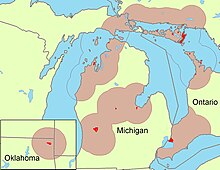 Odawa group areas. | |
| Total population | |
|---|---|
| 15,000 | |
| Regions with significant populations | |
| United States (Oklahoma, Michigan) Canada (Ontario) | |
| Languages | |
| English, French, Ojibwe (Ottawa dialect) | |
| Religion | |
| Midewiwin, Animism, traditional religion, Christianity, other | |
| Related ethnic groups | |
| Ojibwe, Potawatomi, and other Algonquian peoples |
| Person | Daawaa, Odaawaa |
|---|---|
| People | Daawaak, Odaawaag |
| Language | Daawaamwin, Nishnaabemwin |
| Country | Daawaaying, Daawaaw’kii, Nishnaabew’kii |
The Odawa[1] (also Ottawa or Odaawaa /oʊˈdɑːwə/) are an Indigenous American people who primarily inhabit land in the Eastern Woodlands region, now in jurisdictions of the northeastern United States and southeastern Canada. Their territory long preceded the creation of the current border between the two countries in the 18th and 19th centuries.
Their peoples are federally recognized as Native American tribes in the United States and have numerous recognized First Nations bands in Canada. They are one of the Anishinaabeg, related to but distinct from the Ojibwe and Potawatomi peoples.[2]
After migrating from the East Coast in ancient times, they settled on Manitoulin Island, near the northern shores of Lake Huron, and the Bruce Peninsula in the present-day province of Ontario, Canada. They considered this their original homeland. After the 17th century, they also settled along the Ottawa River, and in what became the present-day states of Michigan and Wisconsin. They also occupied other areas of the Midwest south of the Great Lakes in what became the United States.[3] In the 21st century, there are a total of approximately 15,000 Odawa living in Ontario, Canada, and in Michigan and Oklahoma (former Indian Territory, United States).
The Ottawa dialect is part of the Algonquian language family. This large family is made up of numerous smaller tribal groups or "bands," which are commonly called a "Tribe" in the United States and "First Nation" in Canada. Their language is considered a divergent dialect of Ojibwe, characterized by frequent syncope.[4]
- ^ "Odawa Ottawa First Nation Portal Websites". Archived from the original on July 5, 2019. Retrieved March 9, 2019.
- ^ Odawa at The Canadian Encyclopedia, accessed September 4, 2019
- ^ "First Nations Culture Areas Index". Canadian Museum of Civilization.
- ^ "Odawa", Canadian Oxford Dictionary